
15+ Best Prospect Research Tools to Find High-Impact Donors
Whether you’re planning a capital campaign, trying to grow your nonprofit’s legacy giving program, or soliciting the approximately 60% of your annual fundraising revenue that comes from major gifts, prospect research is essential for identifying and cultivating high-impact donors. And like with most other modern nonprofit processes, it’s most effective when you leverage the right tools.
There are hundreds of prospect research solutions and resources available to your organization, but only some of them will help you and your team find the best, most actionable data to inform your cultivation strategies. To narrow down your options, we’ve compiled this guide as a starting point for your nonprofit, which will cover:
- Prospect Research Tools FAQ
- Our Top Picks for Prospect Research Tools
- Making the Most of Your Prospect Research Solutions
Whether you’re just getting started with prospecting or you’re a seasoned pro, you’ve come to the right place to put your organization on track to build stronger donor relationships and achieve its fundraising goals. Let’s dive in!

Prospect Research Tools: Frequently Asked Questions
Before exploring the top prospect research tools on the market, let’s cover the basics of prospect research and relevant solutions by answering some common questions.
What is prospect research?
Prospect research is the process of gathering data that can help your nonprofit find high-impact donors within and beyond its current supporter base. Also known as prospecting or screening, this comprehensive process helps you judge potential donors’ ability and willingness to contribute significantly to your cause—after all, just because someone could make a major gift doesn’t mean they necessarily want to.
When conducting prospect research, you’ll look for three types of data on each potential donor, also known as markers or indicators:

- Capacity indicators show whether a prospect is financially capable of making a large gift to your organization. They include traditional wealth screening markers like real estate ownership, stock market holdings, business affiliations, and political giving history.
- Philanthropic indicators demonstrate a prospect’s philanthropic tendencies and generally include past donations to your organization or other similar nonprofits. You can dive deeper into these indicators by analyzing each donor’s average gift size, frequency and recency of giving, and lifetime value to the organizations they support.
- Affinity indicators let you know if a prospect would be interested in giving to your specific nonprofit and cause. These include a strong connection to or passion for your mission, a history of nonprofit involvement (event attendance, volunteering, board service, etc.), and personal information (e.g., interests and values).
A prospect should exhibit indicators from all three categories for your nonprofit to consider them a viable major giving candidate. The exact data you prioritize will depend on the type of fundraiser you’re conducting.
For example, if your nonprofit is soliciting planned gifts, you’ll want to look for donors who have wills and life insurance policies as well as other wealth indicators. Or, you might focus on different affinity indicators during different capital campaigns—for example, a university giving team would likely approach one group of potential donors if they were fundraising to build a new football stadium and another group during a campaign to expand their performing arts center.
What are prospect research tools?
Prospect research tools include any and all resources that help you learn more about your nonprofit’s current and potential donors. While the term most often refers to software, these tools can range from search engines and social media sites to data appending and consulting services.
The right prospect research solutions for your organization will depend on your needs and budget, as well as how much you already know about your supporters. If you invest in software, make sure it integrates with your nonprofit’s donor database to allow for seamless data transfer. If you use a consulting or data appending service, they should also be comfortable working with your database and various other useful tools.
What should you look for in a prospect research solution?
While it’s important to compare the offerings and pricing of different service providers, prospect research software is often the most challenging to choose because your team needs to be able to use it effectively to meet your unique needs. Brainstorm a list of must-have and nice-to-have features to guide your decision-making, and consider your team’s skill level and implementation timeline in addition to your budget.
Generally speaking, the best prospect research platforms are:

- Precise: Look for a solution you can trust to give you correct, up-to-date, and actionable information from reliable sources.
- Scalable: Think ahead to choose software that will work for your organization now and that will keep up with you as you expand your prospecting efforts in the future.
- User-friendly: Your tools should be easy for everyone on your team to use, which you can determine by reading reviews from other customers and requesting demos from each provider on your shortlist.
- Contemporary: Artificial intelligence (AI) is becoming more prevalent in nonprofit fundraising, so consider if and how you could incorporate AI tools into your prospecting efforts to stay current and competitive.
Approaching this decision with care will help you identify the right prospect research software for your needs and start using it for prospecting sooner and more effectively.

Our Top Picks for Prospect Research Tools
As you review your options for prospect research platforms and resources, consider their affordability and alignment with your unique needs. Here are our top choices from across the market—feel free to browse the entire list or use the table below to jump to specific tools!
DonorSearch
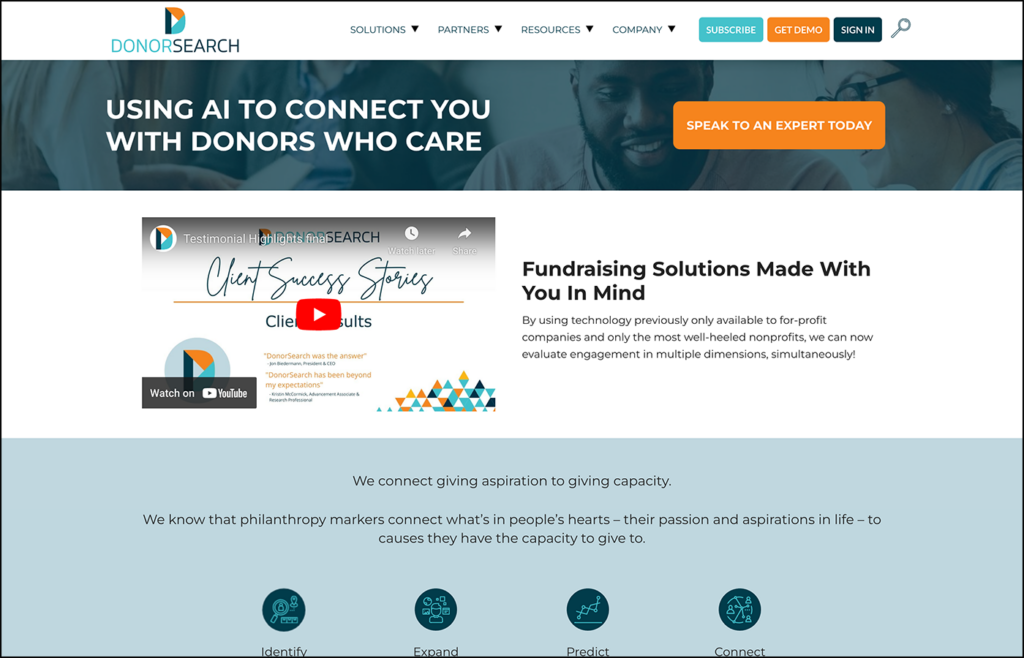
At DonorSearch, we provide the most comprehensive prospect research database on the market, empowering nonprofits of all sizes and missions to reach their fundraising and donor cultivation goals.
Our wealth and philanthropic screening solution has an accuracy rate above 90% and pulls information from a pool of more than one billion data points, updated weekly from dozens of trusted sources. We offer integrations with more than 40 popular donor databases and fundraising tools, so you can easily fit DonorSearch into your organization’s existing processes. And if you ever have a question, you can access our robust resource library or contact your dedicated customer support representative for prompt, personalized assistance.
DonorSearch is also a leader in the AI fundraising space, and our tools build on our success in the prospecting industry. Our AI offerings include:

- DonorSearch Ai: A predictive modeling solution that provides customizable, machine learning-based analysis of prospect research data. It rates potential donors based on their giving capacity and likelihood and prioritizes your prospect lists accordingly so you can reach out to the best candidates first, saving time and resources while driving better results.
- Enhanced CORE: A less complex version of DonorSearch Ai designed for organizations just getting started with fundraising artificial intelligence. It offers standardized predictive models and point-and-click visualization to help your nonprofit ease into AI-powered prospect research (and still glean useful insights!)
- ProspectView Online 2 (PVO2): A prospect reporting tool that builds on our original prospect finder solution by incorporating generative AI. It creates individual reports for each prospect that summarize the most important, actionable information you’ve found on them, giving you a quick reference point to tailor your cultivation strategy.
When you use DonorSearch’s database and AI solutions to connect the dots between what is in a prospect’s heart and their financial portfolio, you can lay a strong foundation for donor relationships that sustain your nonprofit for years to come.

Prospect Visual
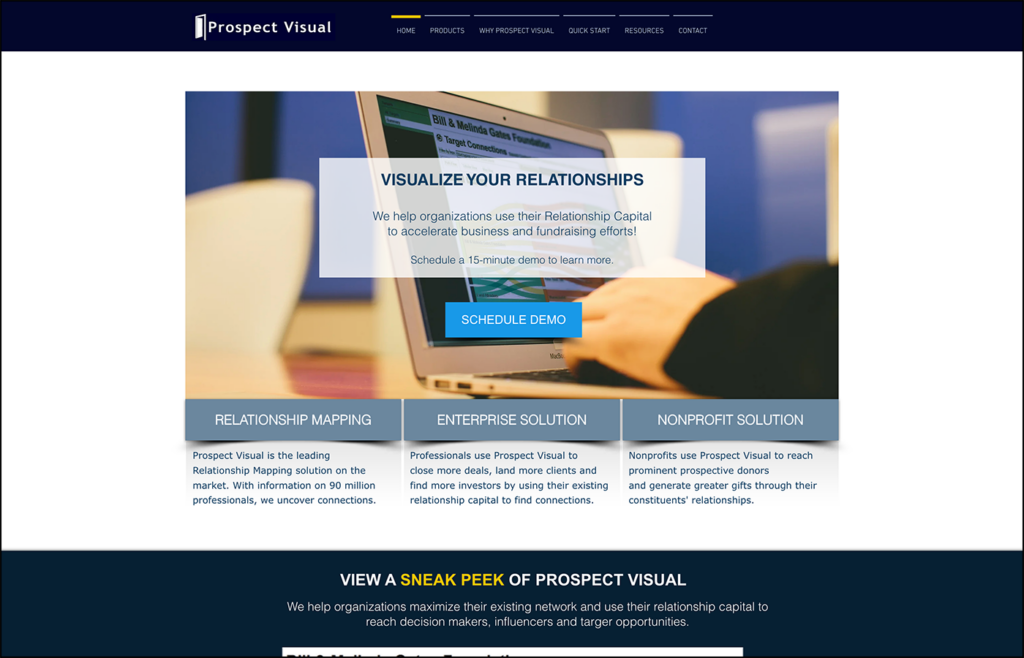
Prospect Visual offers visual relationship-mapping technology that can aid your prospecting and fundraising efforts by illustrating the relationships between your current donors and your prospects. It’s a great solution if your team responds well to visual reporting. Plus, by connecting prospects to current donors, you’ll have an advantage when it comes time to reach out to a prospect—you’ll know someone who can likely make an introduction and help you start the relationship off on the right foot!
Prospect Visual also offers data appending and can help you flesh out your prospect profiles with employment details, educational history, board and nonprofit affiliations, and more.
Pricing
Reach out to the Prospect Visual team to schedule a demo and get more information on pricing.
Instrumentl
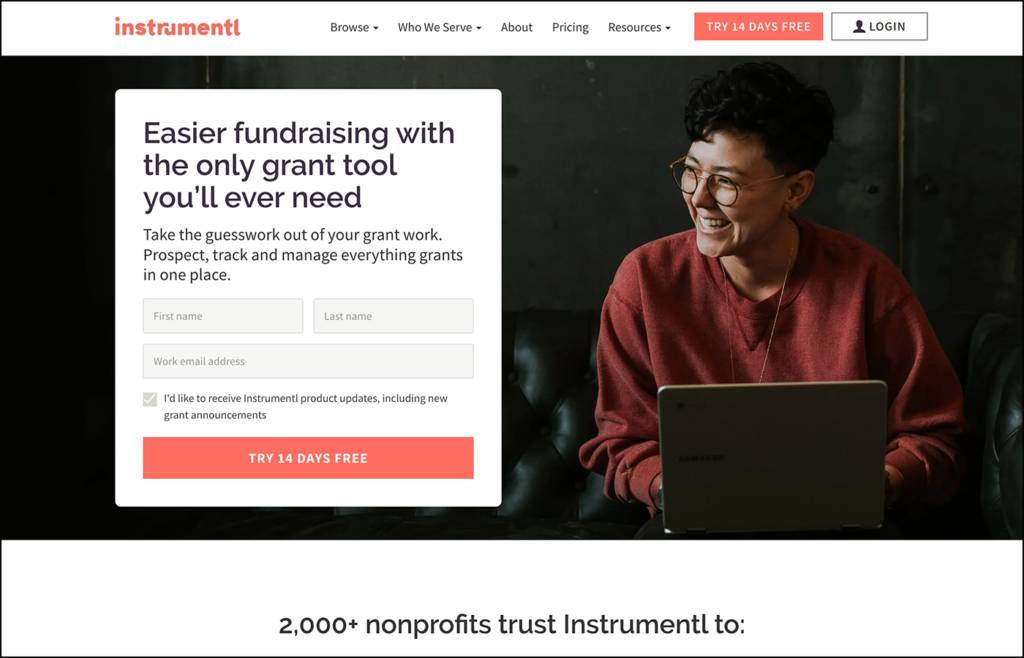
With information on 200,000 funders and over 12,500 active grant opportunities, Instrumentl is a comprehensive source of grant and funder data. So, while it may not be a tool geared toward helping you find individual prospects, it can help your nonprofit identify grant opportunities and make the most of the application process.
Here are some of the features that make Instrumentl a powerful tool:
- Foundation profiles that help you learn about new grantees, geographical giving, grant sizes, and more
- Recipient profiles that show you who has funded similar nonprofits in the past
- Smart matching algorithm that provides you with recommended active grant opportunities and funders to pursue
- Organized workflow to help your team create tasks and update statuses so that you’re always on track to submit your grant applications on time
- Weekly reminders about upcoming deadlines
- Multi-year tracking that helps you plan ahead for renewals with your current funders
With all these great features, Instrumentl can help your nonprofit get results from your grant work. In fact, the platform reports that, on average, users raise $200,000 in new grants in their first twelve months of using Instrumentl.
Pricing
Instrumentl offers a 14-day free trial. After that, your nonprofit can choose from a basic plan ($179/month), a standard plan ($299/month), a professional plan ($499/month), or a custom-designed plan.
Donorly
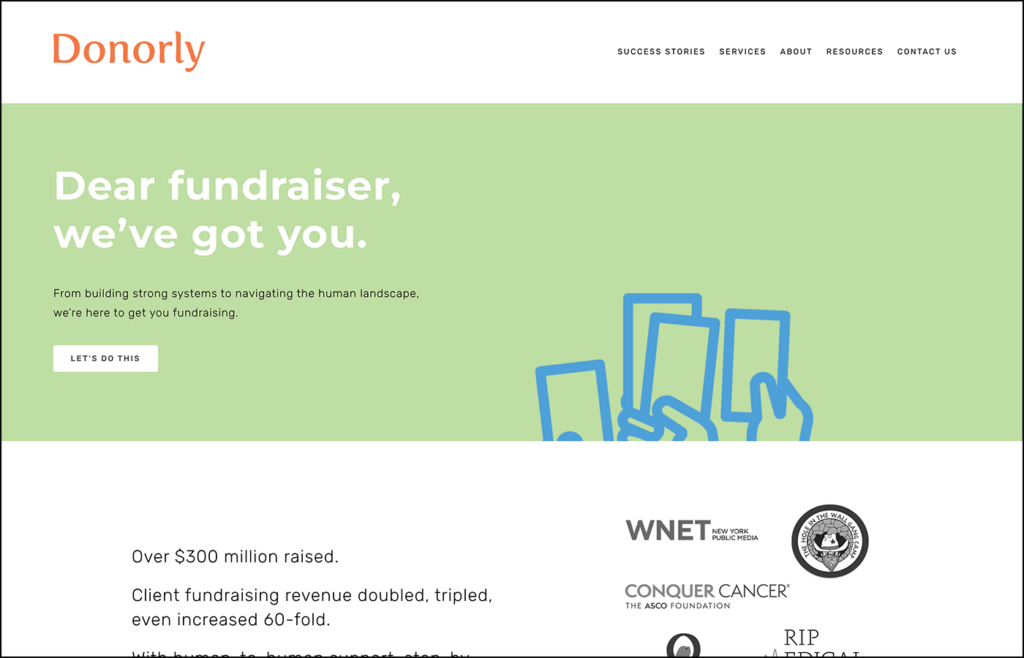
Donorly isn’t a traditional prospect research tool. Instead, it’s a nonprofit consulting firm led by fundraising and capacity-building experts who can assist your nonprofit in growing its donor pool through prospect research. You can work with Donorly to purchase a five-, 10-, or 20-hour prospect research subscription. The Donorly team will use this time to tap into their arsenal of prospect research tools and help you learn more about your current and future donors.
Additionally, Donorly provides other services that your nonprofit may need while prospecting, such as transitional staffing services, telefundraising training, capital campaign counsel, and fundraising feasibility studies.
Pricing
Contact Donorly to learn more about their pricing.
Double the Donation
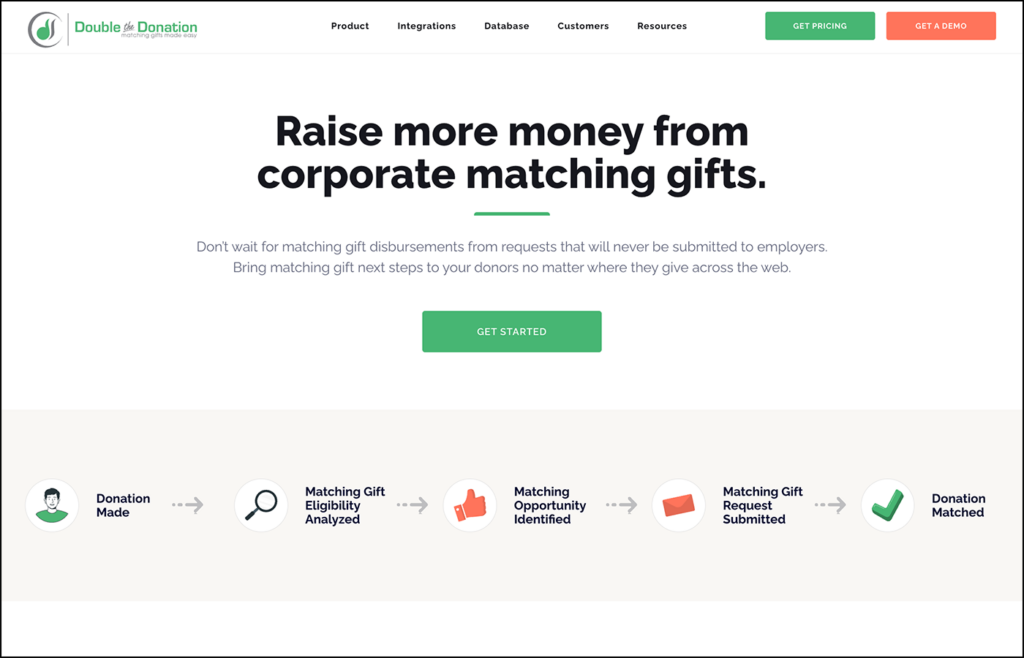
Did you know that many of your donors and prospects may be eligible to have their employers financially match their charitable contributions? This is a type of corporate philanthropy known as matching gifts, and Double the Donation can help you tap into it.
Double the Donation offers a user-friendly matching gift tool that you can add to your donation forms and website that will help you and your donors discover whether or not they’re eligible for gift matching. Plus, Double the Donation now offers matching gift automation, allowing your donors to submit their work email addresses and have their gift-matching information submitted to their employers without lifting a finger. This means donors can get their contributions doubled faster!
Pricing
Double the Donation offers different pricing plans based on your organization’s size and matching gift revenue. Their small nonprofit plan costs $999/year, while their mid-sized plan costs $1,500/year. Custom pricing is also available for large organizations.
Zillow
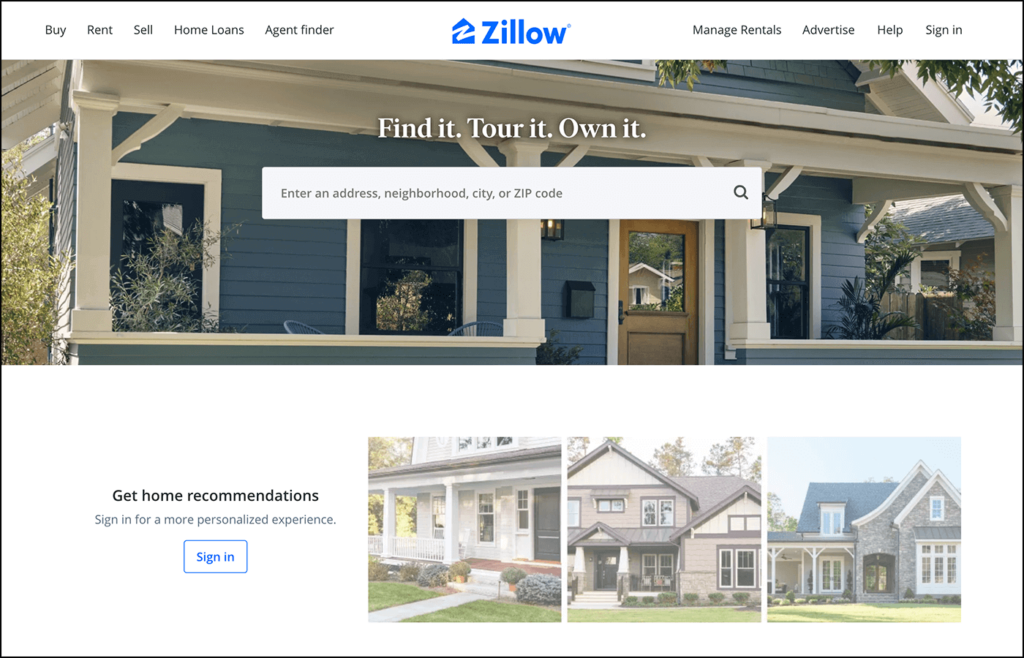
Zillow is a popular real estate website. On the site, you simply type in an address, neighborhood, city, or ZIP code to browse real estate listings and their estimated values.
Since real estate ownership is a capacity marker that you can use to determine whether or not an individual is able to make a large gift, you can use Zillow to look up a prospect’s current or past properties to get a fuller picture of their capacity. This information can also help you make an informed first donation ask when the time is right.
Pricing
Zillow is completely free to use! Simply create a profile and begin searching.
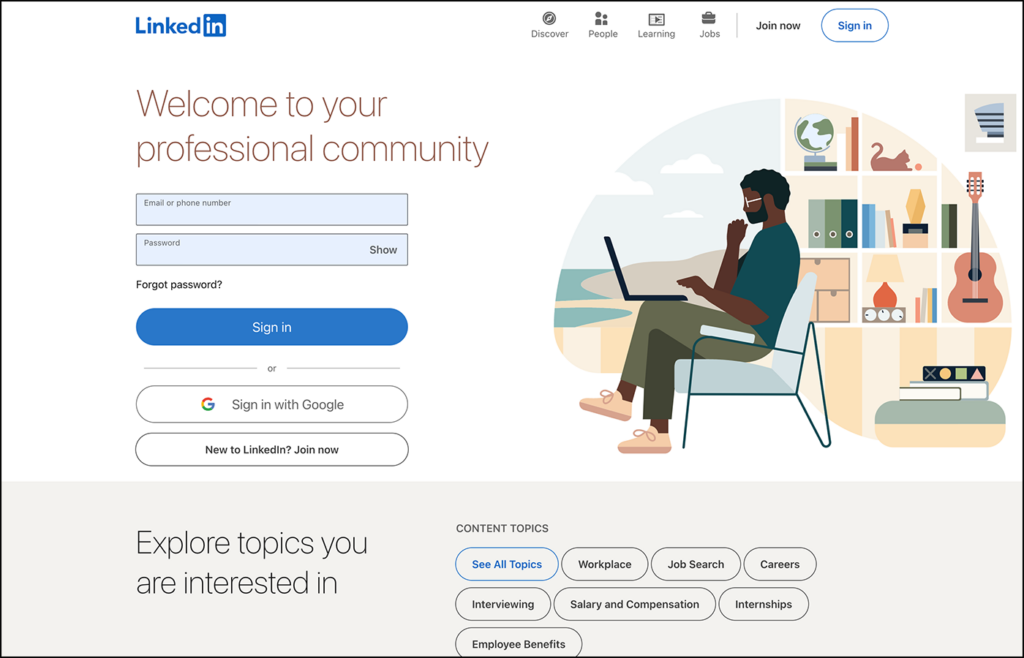
If you’re looking to add information to your donor prospect profiles, LinkedIn is the place to go. It’s a professional networking site and can be a great source for information like:
- Education history
- Current or previous employers
- Common professional connections
Plus, if your prospects or donors are active on LinkedIn and post regularly, you may see updates on their professional lives come through your feed. This gives your organization another touchpoint with your prospects and donors—you can like the updates or even comment your thoughts. Plus, you’ll have something current to talk about the next time you catch up with the prospect.
Pricing
LinkedIn is free to use, but you can pay for a premium version to unlock additional features.
Federal Election Commission (FEC) Filings

The FEC’s records can give your nonprofit information about your prospects’ political giving habits. All you need to do is type in a prospect’s name and any other information like the individual’s ZIP code, city, or employer. You’ll then be able to see what candidate or party they donated to, how much they gave, and when.
These records can give you information about a prospect’s giving capacity, and, depending on your mission, they may also indicate an affinity for your cause. For example, you may discover that a certain prospect donated to a political candidate with values that are similar to your nonprofit’s mission.
Pricing
The FEC’s filings are completely free for anyone to browse.
Security and Exchange Commission (SEC) Records

Similar to the FEC, the SEC also provides publicly-available information, namely quarterly and annual reports and stockholder information. Similar to the FEC site, you simply type in an individual’s name or a particular company’s ticker symbol. Since stock holdings can signal a prospect’s capacity, this will be valuable information for your organization to review.
Pricing
SEC filings are also completely free to use.
Million Dollar List
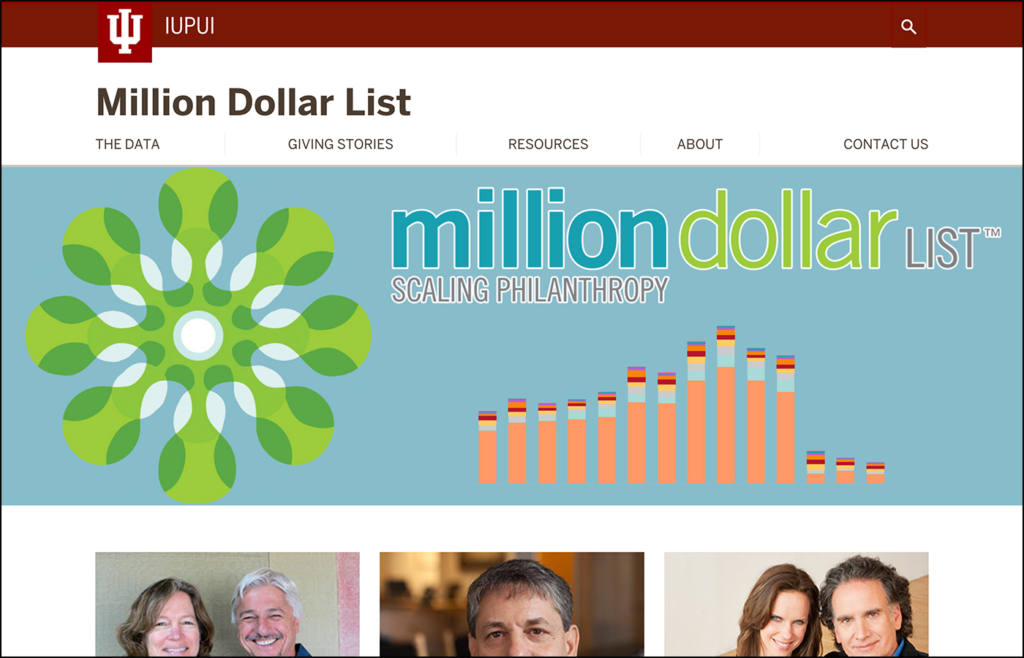
The Million Dollar List is a prospect research resource compiled by the Indiana University Lilly Family School of Philanthropy. It collects information on publicly-announced charitable contributions of $1 million or more. You can search the Million Dollar List by:
- Specific donors
- Recipient organizations
- Geographic location
- Charitable subsector
- Donation size
Information about such large gifts can not only give you an idea of a prospect or donor’s wealth, but also their affinity for nonprofit causes like yours!
Pricing
The Million Dollar List is free for anyone to use.
FreeWill
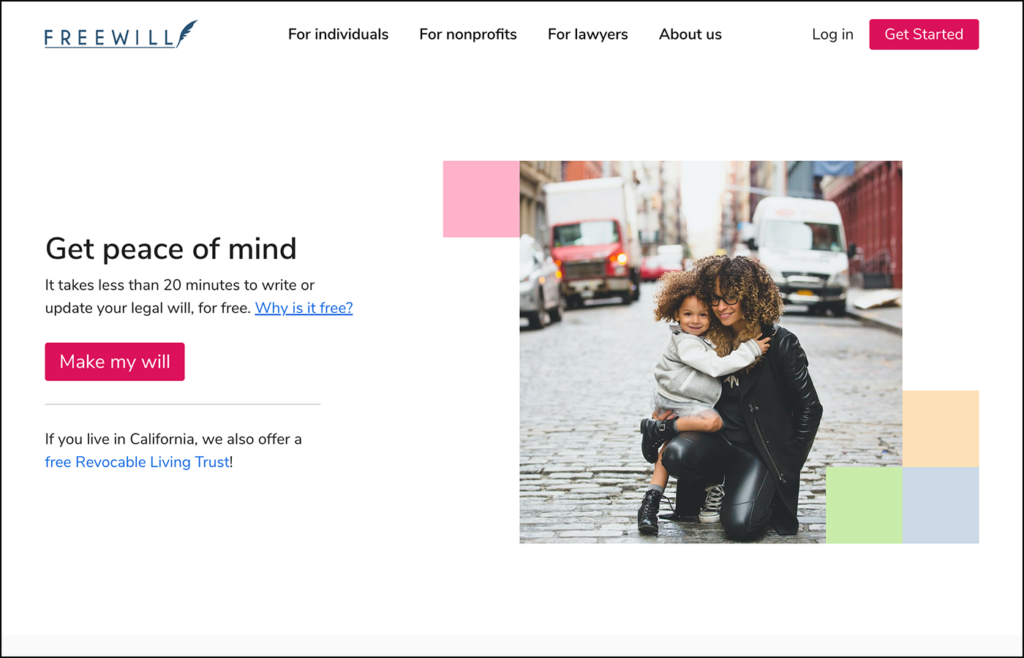
Most of the time when nonprofits talk about major donations, they’re likely thinking of cash gifts. But non-cash gifts can be extremely valuable, especially for growing nonprofits. Non-cash gifts might include:
- Bequests
- Stocks, bonds, and ETFs
- Qualified charitable distributions from IRAs
- Crypto donations
FreeWill can help your nonprofit discover these gifts and offers a variety of organizational-facing and donor-facing tools to make this possible. For example, they can help you offer donors the option to make a non-cash donation and then assist in liquidating gifts of stock and cryptocurrency.
According to FreeWill, when nonprofits focus on non-cash gifts, they can grow six times faster than they would with just cash alone. Give their platform a try to discover unique forms of gifts or to grow your planned giving program!
Pricing
Contact FreeWill for pricing information.
AlumniFinder
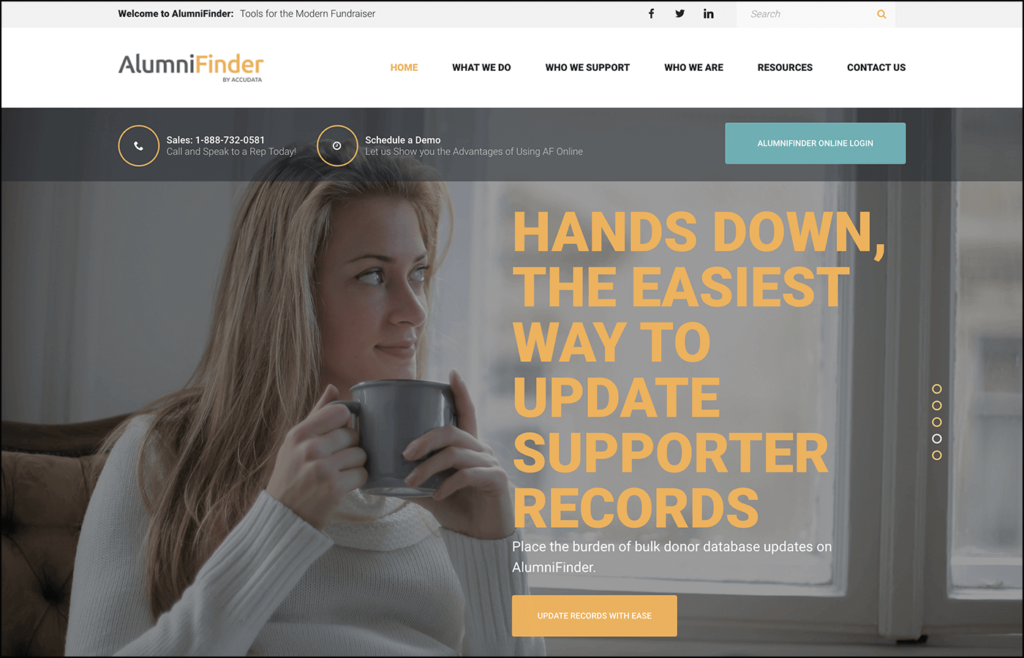
AlumniFinder believes in the power of data to drive fundraising results. It is a great option for educational institutions, healthcare organizations, and other nonprofits. AlumniFinder’s tools can help your organization update its donor database, discover more about your donors and prospects, and use analytics to segment your donors for more successful cultivation moves.
Additionally, AlumiFinder can help manage your digital campaigns through fine-tuned email strategies and online targeting.
Pricing
Reach out to the AlumniFinder team to learn more about pricing.
Fundraising Report Card
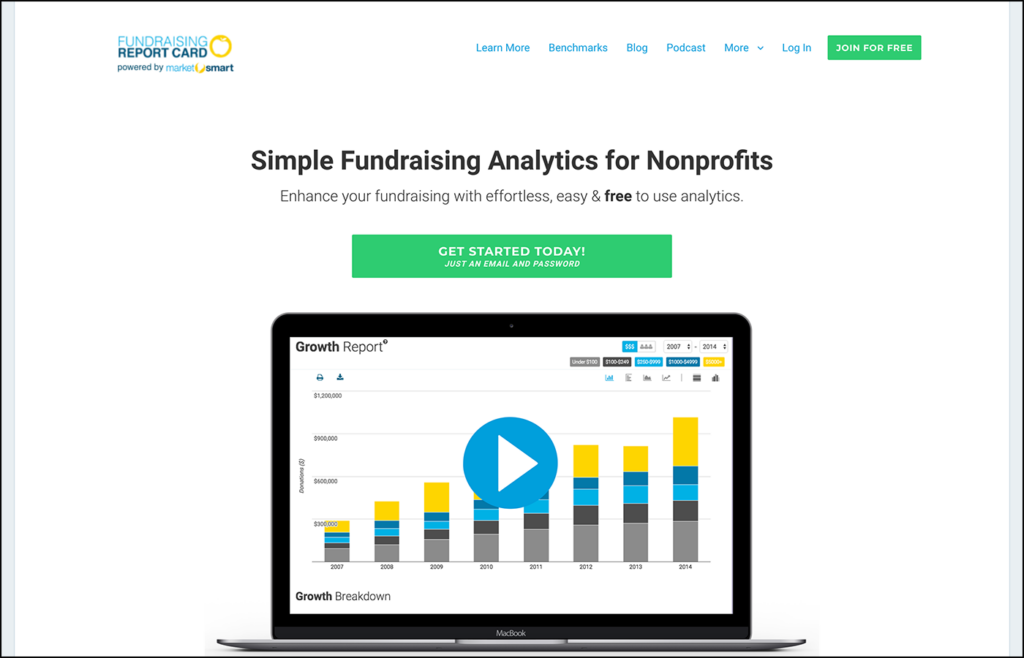
Fundraising Report Card is a prospect research tool that provides performance analytics and reporting for nonprofits. Powered by your organization’s data, Fundraising Report Card can help you measure and analyze key metrics like donation growth, donor churn, and retention rate. It can also help your team focus its attention on recovering lost donors and prospects by empowering you to create customized report segments that allow you to visualize which prospects and donors to reach out to.
Plus, with this tool, you can present your data to your stakeholders in a digestible, visual format.
If you’re looking to make more sense of your donor data, Fundraising Report Card can help!
Pricing
Fundraising Report Card offers both free and paid plans based on your organization’s needs. Contact them for more information!
Chronicle of Philanthropy

The Chronicle of Philanthropy is a valuable nonprofit resource and prospect research tool. Not only does the Chronicle provide news updates about the nonprofit sector, but it also offers a variety of useful reports and datasets you can use while prospecting.
For example, the Chronicle recently published the newest edition of “The Philanthropy 50,” a list of America’s fifty biggest donors. You can browse through these lists by name, donation amount, source of wealth, location, and cause. Plus, you can look at past Philanthropy 50 lists dating back to 2000.
The Chronicle also offers a free database of charitable gifts of $1 million or more, similar to the Million Dollar List. You can sort this database by cause and donation size.
Pricing
Much of the Chronicle’s content is free to access, but some of it is protected by a paywall. To get a custom quote for a subscription for your organization, contact the Chronicle. You can also subscribe as an individual for $109.95/year.
Social Media Platforms
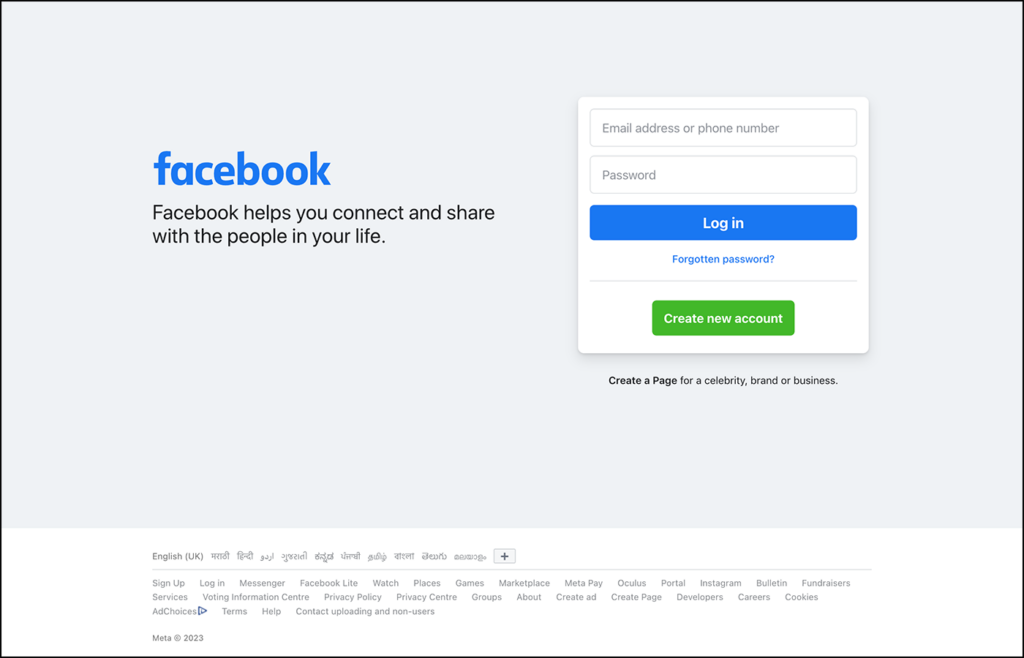
Believe it or not, social media platforms like Facebook can be beneficial for prospect research. Here are a few examples of how your organization might use social media platforms to learn more about its donors and prospects:
- Your executive director might have a friend in common with a prospective donor, and could reach out and ask the mutual friend to make an introduction.
- Your social media manager might notice that a prospect often interacts with the posts on your organization’s page, and could initiate outreach on social media.
- One of your board members might know a prospect well and see their life updates on social media, helping your organization learn more about that prospect’s values, interests, and hobbies.
Whether you opt to use Facebook, Instagram, X, or another platform to get to know your donors and prospects, these tools can be valuable in helping you learn more personal information about them that can supplement what you already know about their educational history or professional life.
Pricing
Facebook, Instagram, and X are free for all users.
TouchPoints
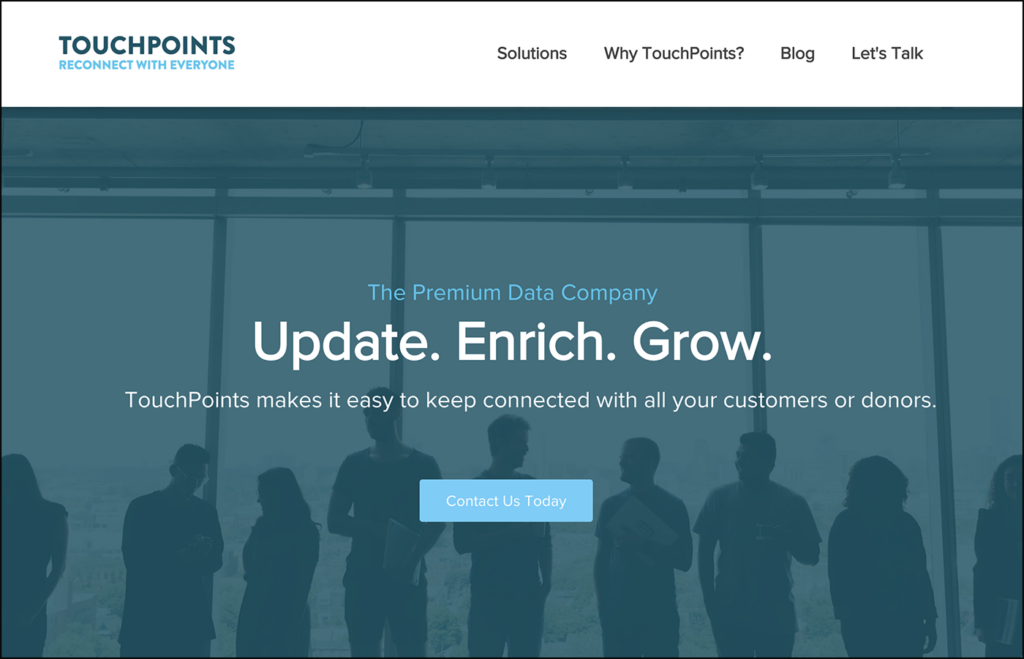
TouchPoints is another prospect research tool that can help you keep your nonprofit’s database clean and useful. They focus on key data elements like full name, postal address, phone number, age, deceased screening, education, demographics, and social media.
TouchPoints can monitor your data and proactively inform you when anything has changed. But that’s not all—they’ll help you append your data with the most accurate information available, too.
Pricing
Get in touch with the TouchPoints team to get pricing information.
Making the Most of Your Prospect Research Solutions
Now that you’ve explored our list of the best prospect research tools on the market, you likely have an idea of the solutions your team needs to invest in to optimize the prospecting process. Once you get up and running with a tool (or a few tools), use these tips to get as much value out of it as possible:

- Train your team to use the software. For prospect research platforms to be truly useful, the people on your team who will be using them most often need to know how to leverage them as part of their regular workflow. If possible, have them watch a demo or attend a training session led by the provider. And don’t forget to take advantage of ongoing customer service offerings to make sure your team gets all of their questions answered!
- Keep your data clean. Much of your prospecting work relies on the data your organization already has in its donor database. Regularly audit your database to remove outdated, duplicate, or ambiguous information so it can continue to provide useful insights as you identify and reach out to prospects. You should also consider having your data appended if you find information gaps.
- Create individual profiles for each prospect. As soon as a prospect makes contact with your nonprofit, make a donor profile for them in your database to store all of the important information you find on them in one place. Treat donor profiles as living documents—return to your profiles each time you interact with a prospect so you can make updates throughout the cultivation process and plan your next moves.
Additionally, while building relationships with donors is essential, remember the “why” behind your major gift fundraising efforts. Strive to connect your research to your larger mission, and remind yourself often about your end goal for prospecting—to better serve your community!
Final Thoughts
The better your prospect research tools, the better your prospect research efforts will be. This list of top providers is just your first stop—do your homework on the tools that make it to the top of your nonprofit’s list before making your final decision. As you leverage your chosen software and resources, you’ll be better equipped to find the right prospective donors for all of your organization’s large-scale fundraising needs.
For more information on prospect research and its applications, check out these resources:
- What Is a Capital Campaign? Ultimate Guide for Nonprofits. Discover everything it takes to run a successful capital campaign, from goals to personnel to tools.
- AI Fundraising for Nonprofits: Embracing the New Frontier. Dive deeper into the benefits, use cases, and considerations of AI fundraising for prospecting and beyond.
- Donor Cultivation: The Basics + 6 Standout Strategies. Once you’ve conducted prospect research and identified potential donors, learn how to build relationships with them to secure their sustained support.

